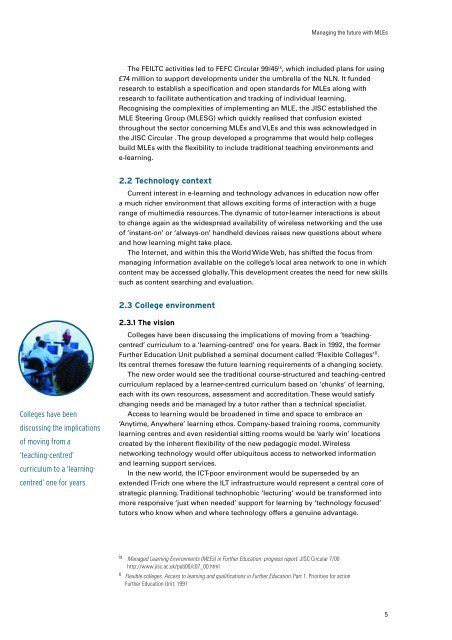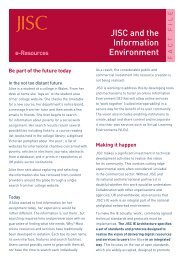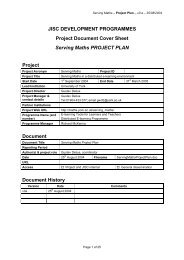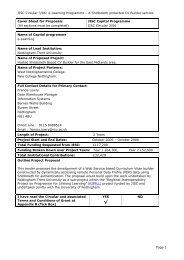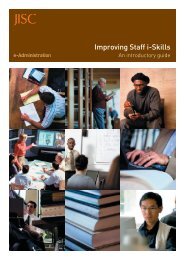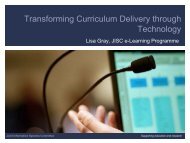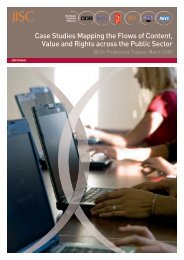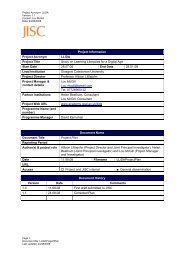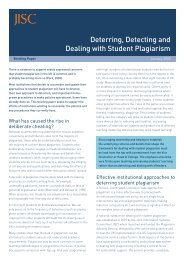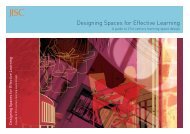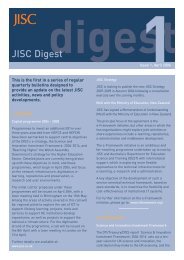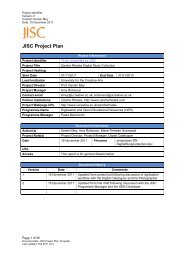Managing the future with MLEs - Jisc
Managing the future with MLEs - Jisc
Managing the future with MLEs - Jisc
Create successful ePaper yourself
Turn your PDF publications into a flip-book with our unique Google optimized e-Paper software.
<strong>Managing</strong> <strong>the</strong> <strong>future</strong> <strong>with</strong> <strong>MLEs</strong><br />
The FEILTC activities led to FEFC Circular 99/45 ix , which included plans for using<br />
£74 million to support developments under <strong>the</strong> umbrella of <strong>the</strong> NLN. It funded<br />
research to establish a specification and open standards for <strong>MLEs</strong> along <strong>with</strong><br />
research to facilitate au<strong>the</strong>ntication and tracking of individual learning.<br />
Recognising <strong>the</strong> complexities of implementing an MLE, <strong>the</strong> JISC established <strong>the</strong><br />
MLE Steering Group (MLESG) which quickly realised that confusion existed<br />
throughout <strong>the</strong> sector concerning <strong>MLEs</strong> and VLEs and this was acknowledged in<br />
<strong>the</strong> JISC Circular . The group developed a programme that would help colleges<br />
build <strong>MLEs</strong> <strong>with</strong> <strong>the</strong> flexibility to include traditional teaching environments and<br />
e-learning.<br />
2.2 Technology context<br />
Current interest in e-learning and technology advances in education now offer<br />
a much richer environment that allows exciting forms of interaction <strong>with</strong> a huge<br />
range of multimedia resources. The dynamic of tutor-learner interactions is about<br />
to change again as <strong>the</strong> widespread availability of wireless networking and <strong>the</strong> use<br />
of ‘instant-on’ or ‘always-on’ handheld devices raises new questions about where<br />
and how learning might take place.<br />
The Internet, and <strong>with</strong>in this <strong>the</strong> World Wide Web, has shifted <strong>the</strong> focus from<br />
managing information available on <strong>the</strong> college’s local area network to one in which<br />
content may be accessed globally. This development creates <strong>the</strong> need for new skills<br />
such as content searching and evaluation.<br />
2.3 College environment<br />
Colleges have been<br />
discussing <strong>the</strong> implications<br />
of moving from a<br />
‘teaching-centred’<br />
curriculum to a ‘learningcentred’<br />
one for years<br />
2.3.1 The vision<br />
Colleges have been discussing <strong>the</strong> implications of moving from a ‘teachingcentred’<br />
curriculum to a ‘learning-centred’ one for years. Back in 1992, <strong>the</strong> former<br />
Fur<strong>the</strong>r Education Unit published a seminal document called ‘Flexible Colleges’ x .<br />
Its central <strong>the</strong>mes foresaw <strong>the</strong> <strong>future</strong> learning requirements of a changing society.<br />
The new order would see <strong>the</strong> traditional course-structured and teaching-centred<br />
curriculum replaced by a learner-centred curriculum based on ‘chunks’ of learning,<br />
each <strong>with</strong> its own resources, assessment and accreditation. These would satisfy<br />
changing needs and be managed by a tutor ra<strong>the</strong>r than a technical specialist.<br />
Access to learning would be broadened in time and space to embrace an<br />
‘Anytime, Anywhere’ learning ethos. Company-based training rooms, community<br />
learning centres and even residential sitting rooms would be ‘early win’ locations<br />
created by <strong>the</strong> inherent flexibility of <strong>the</strong> new pedagogic model. Wireless<br />
networking technology would offer ubiquitous access to networked information<br />
and learning support services.<br />
In <strong>the</strong> new world, <strong>the</strong> ICT-poor environment would be superseded by an<br />
extended IT-rich one where <strong>the</strong> ILT infrastructure would represent a central core of<br />
strategic planning. Traditional technophobic ‘lecturing’ would be transformed into<br />
more responsive ‘just when needed’ support for learning by ‘technology focused’<br />
tutors who know when and where technology offers a genuine advantage.<br />
ix Managed Learning Environments (<strong>MLEs</strong>) in Fur<strong>the</strong>r Education: progress report. JISC Circular 7/00<br />
http://www.jisc.ac.uk/pub00/c07_00.html<br />
x Flexible colleges. Access to learning and qualifications in Fur<strong>the</strong>r Education. Part 1. Priorities for action<br />
Fur<strong>the</strong>r Education Unit: 1991<br />
5


